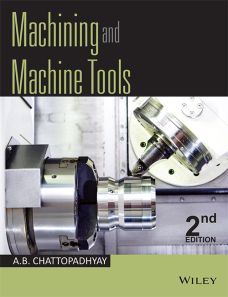Machining and Machine Tools, 2ed
ISBN: 9788126564743
844 pages
eBook also available for institutional users
For more information write to us at: acadmktg@wiley.com

Description
Machining and machine tools is a text targeted towards the students and teachers for the
undergraduate Manufacturing Processes course in the Mechanical Engineering discipline. Postgraduate students in the production and manufacturing streams will also find this book a good reference.
This book brings a holistic approach to the understanding of machine tools and manufacturing
processes, giving equal emphasis to historical background and chronological development, and to modern developments in manufacturing and contemporary machining processes.
Preface to the Second Edition
Preface to the First Edition
About the Author
Part A – Machining
1 Introduction to Machining
1.1 Introduction
1.2 Engineering Manufacturing
1.3 Machining
1.4 Need or Benefits of Learning ‘Theory of Machining’
1.5 Major Aspects and Topics to be Studied under Machining
1.6 Solved Problems
2 Geometry of Cutting Tools
2.1 Introduction
2.2 Geometry of Single-Point Turning Tools
2.3 Geometry of Multiple-Point Cutting Tools
2.4 Conversion of Tool Angles
2.5 Solved Problems
3 Mechanism of Machining
3.1 Introduction
3.2 Purpose of Studying Mechanism of Chip Formation in Machining
3.3 Mechanism of Chip Formation in Machining
3.4 Geometry and Characteristics of Continuous Chip Formation
3.5 Chip Formation in Drilling
3.6 Chip Formation Mechanism in Milling
3.7 Solved Problems
4 Mechanics of Machining
4.1 Introduction
4.2 Generation of Cutting Forces and the Effects of the Cutting Forces in Machining
4.3 Cutting Force Analysis and Estimation
4.4 Analysis and Estimation of Forces under Oblique Cutting
4.5 Mechanics and Estimation of Drilling and Milling Forces
4.6 Measurement of Cutting Forces
4.7 Design Considerations for Tool–Force Dynamometers
4.8 Construction of Typical Tool–Force Dynamometers and Their Functioning
4.9 Solved Problems
5 Heat Generation and Cutting Temperature in Machining
5.1 Introduction
5.2 Location and Causes of Heat Generation in Machining
5.3 Effects of Cutting Temperature on Job and Tool
5.4 Determination of Cutting Temperature
5.5 Control of Cutting Temperature and Application of Cutting Fluid
5.6 Solved Problems
6 Failure

